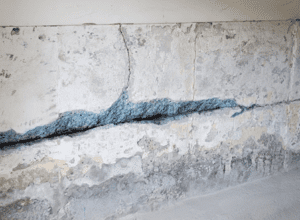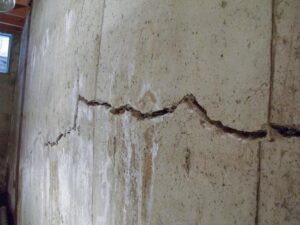The foundation of your home is its literal and metaphorical bedrock, providing stability and support. However, when cracks begin to appear in the basement walls, it’s a sign that the foundation is undergoing stress and may be in need of attention. In this comprehensive guide, we will delve into the various aspects of basement wall cracks, including their common causes, the potential risks they pose, and effective strategies for identifying, preventing, and addressing these structural concerns.
The Anatomy of Basement Wall Cracks:
Types of Cracks:
Basement wall cracks can manifest in different forms, each indicating distinct causes and potential risks. Vertical cracks may result from settling, while horizontal cracks could signal more severe structural issues. Diagonal cracks often point to lateral pressure, and stair-step cracks may indicate foundation movement.
Common Causes of Basement Wall Cracks:
Understanding the factors that contribute to basement wall cracks is essential for effective resolution. Common causes include:
Soil Settlement: Changes in the soil around the foundation, such as shrinking or expanding clay soil, can lead to settlement and subsequent cracking.
Hydrostatic Pressure: Elevated water levels in the soil, often due to heavy rainfall or snowmelt, exert hydrostatic pressure on the foundation walls, causing cracks.
Freeze-Thaw Cycles: In colder climates, repeated freeze-thaw cycles can cause the concrete to expand and contract, leading to cracks over time.
Poor Construction Practices: Inadequate construction techniques, the use of low-quality materials, or insufficient reinforcement can contribute to the development of cracks.
Recognizing the Risks Associated with Basement Wall Cracks:
Water Infiltration:
Perhaps the most immediate concern with basement wall cracks is the potential for water infiltration. Even hairline cracks can allow moisture to seep in, leading to dampness, mold growth, and damage to stored belongings.
Structural Compromises:
Basement wall cracks, if left unaddressed, can compromise the structural integrity of your home. They may lead to further movement, settlement, or bowing of the walls, posing significant risks to the stability of the entire structure.
Mold and Mildew Growth:
Moisture entering through cracks creates an ideal environment for mold and mildew growth. These fungi not only damage the structural components of your home but also pose health risks to occupants, particularly those with respiratory conditions.
Decreased Property Value:
Homes with visible foundation issues, such as basement wall cracks, often experience a decrease in property value. This can make it challenging to sell the home and may result in financial setbacks for homeowners.
Electrical and Plumbing Issues:
As the foundation shifts or settles due to cracks, it can impact the infrastructure within the home. This includes electrical wiring and plumbing systems, leading to potential hazards and costly repairs.
Identifying Basement Wall Cracks:
Visual Inspection:
Conduct a thorough visual inspection of your basement walls. Look for cracks of any size, noting their location, length, and orientation. Pay attention to corners, where cracks are more likely to appear.
Monitoring Changes:
Regularly monitor existing cracks for any changes. An increase in length, width, or the appearance of new cracks can indicate ongoing structural issues that require attention.
Interior Signs of Water Damage:
Look for signs of water damage, such as damp spots, discoloration, or mold growth on the basement walls. These may be indicative of water infiltration through cracks.
Exterior Inspection:
Inspect the exterior of your home, paying attention to the foundation. Look for gaps, separations, or bulging in the foundation walls. These external signs can provide insights into the severity of basement wall cracks.
Professional Inspection:
Consider hiring a professional structural engineer or foundation specialist to conduct a comprehensive inspection. Their expertise can help identify the root causes of the cracks and guide you in developing an effective repair strategy.
Strategies for Preventing and Addressing Basement Wall Cracks:
Maintain Consistent Moisture Levels:
Keep the soil around the foundation consistently moist to prevent excessive expansion and contraction, particularly in regions with clay soil. Proper landscaping and irrigation practices can help regulate soil moisture.
Proper Grading:
Ensure that the grading around your home slopes away from the foundation. This prevents water from pooling near the basement walls, reducing the risk of hydrostatic pressure-induced cracks.
Install Drainage Systems:
Consider installing exterior drainage systems, such as French drains or weeping tiles, to redirect water away from the foundation. Interior drainage systems, like a sump pump, can also help manage water infiltration.
Waterproofing:
Apply waterproofing coatings or sealants to the exterior of the basement walls. This additional layer provides a barrier against water penetration and helps prevent cracks from forming or worsening.
Address Gutter Issues:
Maintain gutters and downspouts in good condition. Clean them regularly to prevent clogs, and ensure that downspouts direct water away from the foundation. Proper gutter function reduces the risk of water-related issues.
Reinforce Foundation During Construction:
If you are building a new home or undertaking significant renovations, invest in proper foundation reinforcement. Quality construction practices and materials can mitigate the likelihood of basement wall cracks.
Crack Injection:
For smaller cracks, crack injection involves injecting epoxy or polyurethane materials into the cracks to fill and seal them. This is a cost-effective solution for preventing water infiltration and further damage.
Carbon Fiber Reinforcement:
Carbon fiber strips or plates can be applied to basement walls to reinforce and stabilize them. This is particularly effective for addressing bowing or leaning walls caused by cracks.
Underpinning:
In cases of significant settlement or foundation movement, underpinning may be necessary. This involves strengthening the foundation by extending its depth or adding supportive structures.
Wall Anchors:
Wall anchors are used to stabilize and straighten bowing or leaning walls. They are anchored deep into the soil outside the foundation and connected to the interior walls, providing additional support.
Helical Piers:
Helical piers are screw-like devices that are drilled into stable soil to support and lift the foundation. This is a common solution for homes with foundation settlement or subsidence.
Complete Wall Rebuilding:
In extreme cases, where basement wall cracks are severe and compromise the structural integrity, complete wall rebuilding may be necessary. This involves demolishing the damaged walls and constructing new ones.
Regular Maintenance and Inspections:
Implement a routine maintenance schedule and conduct regular inspections of your basement and foundation. This proactive approach allows you to identify and address issues before they escalate into more significant problems.
Basement wall cracks are not just cosmetic issues; they are early indicators of potential threats to the structural integrity and safety of your home. Understanding the causes, recognizing the risks, and implementing preventive measures are crucial steps in preserving the foundation of your property. Regular inspections, proper maintenance, and timely repairs can prevent basement wall cracks from evolving into more serious problems, ensuring the long-term stability and value of your home. Remember, addressing basement wall cracks early is an investment in the longevity and safety of your most valuable asset—your home.
Contact the Professionals at Seal-Tite Basement Waterproofing Today! 540-992-1144

Seal-tite Basement Waterproofing Co. is a full service basement environment contractor. We carry an A+ Better Business Bureau rating. We repaired over 40,000 homes and structures in Virginia, West Virginia, Tennessee, and North Carolina. We are fully insured and licensed. We have worked in all types of locations, including residential and commercial locations, government agencies, colleges, hospitals, churches, and condo associations.
Seal-tite® offers a lifetime transferable warranty. We carry a Class A Contractor’s License and we are fully insured. Our satisfied customers range from government agencies to businesses, hospitals, colleges, churches, and thousands of homeowners. Your home is probably the single largest investment you will make in your lifetime. Don’t wait, call Seal-tite® to help make your home dry, safe and livable.


 Call or email for a free estimate. For immediate help call
Call or email for a free estimate. For immediate help call  Start with trust. We’re BBB A+ Rated The Top Satisfaction Rate Awarded.
Start with trust. We’re BBB A+ Rated The Top Satisfaction Rate Awarded.